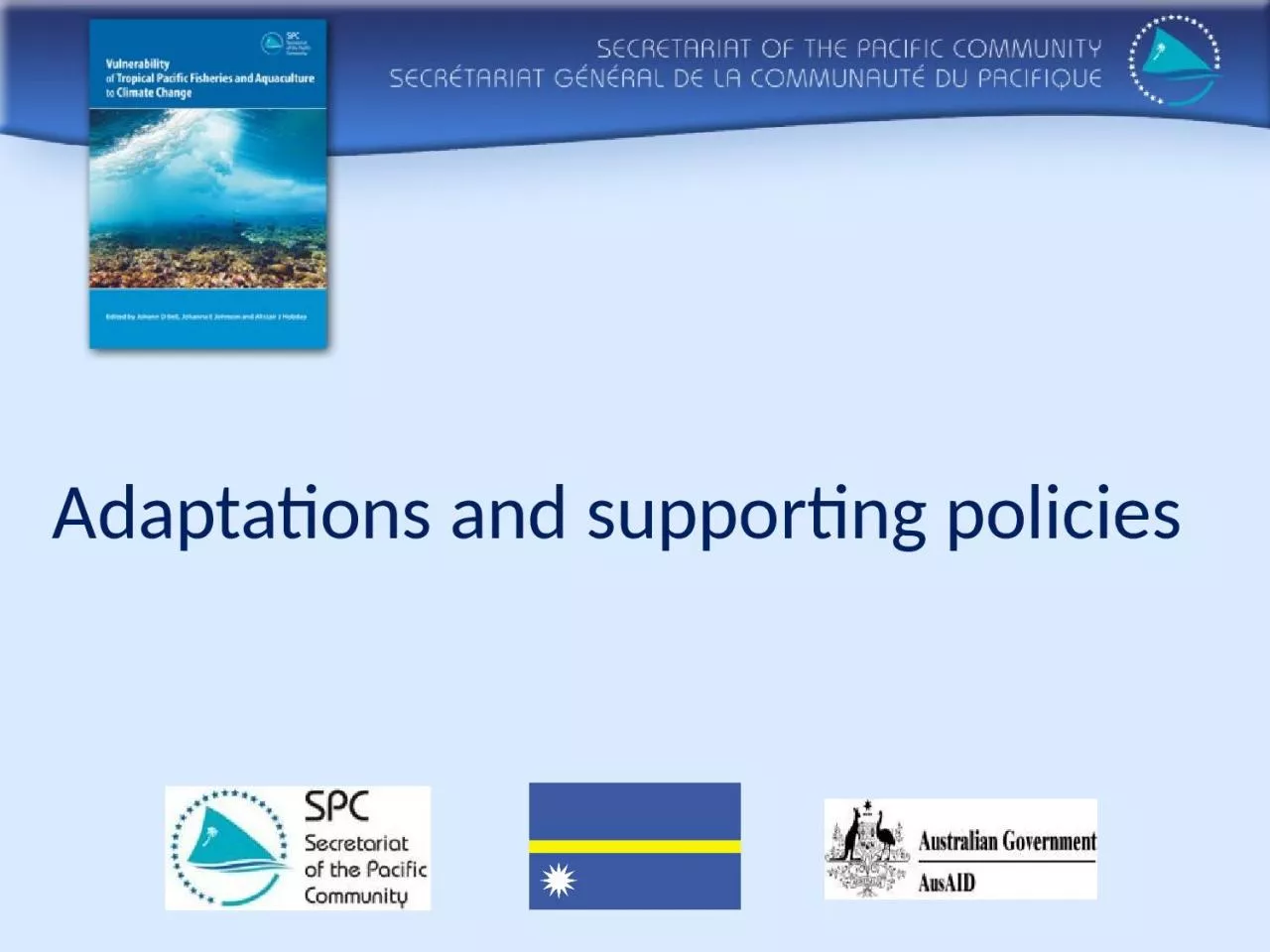

Based on Chapter 13 Outline Framework for adaptations Winwin adaptations Supporting policies Adaptation decision framework LoseLose X X ID: 1002732
Download Presentation The PPT/PDF document "Adaptations and supporting policies" is the property of its rightful owner. Permission is granted to download and print the materials on this web site for personal, non-commercial use only, and to display it on your personal computer provided you do not modify the materials and that you retain all copyright notices contained in the materials. By downloading content from our website, you accept the terms of this agreement.
1. Adaptations and supporting policies
2. Based on Chapter 13
3. OutlineFramework for adaptationsWin-win adaptationsSupporting policies
4. Adaptation decision frameworkLose-Lose X XLose-Win XWin-WinxXLong-term LossLong-term GainNear-term GainNear-term LossAddresses climate changeAddresses present driversAfter Grafton (2010)Win-Lose
5. Practical adaptations and policies are needed to:Harness the opportunities expected from greater abundances of tunaReplace the fish lost from degraded coral reefsCapitalise on the improved conditions for pond aquaculture Adaptations and policies
6. Adaptations for tuna Ask L-WW-WL-LW-LLa NiñaEl NiñoSource of map: Lehodey et al. (1977)‘Vessel Days Scheme’ to manage effort of industrial tuna fleets Cap and trade provisions of VDS enable all PNA members to receive some benefits during ENSO events, regardless of where tuna are concentrated
7. Adaptations for tuna Ask L-WW-WL-LW-LS‘Vessel Days Scheme’ to manage effort of industrial tuna fleetsSource: Bell et al. (2011) and Lehodey et al. (2011) Allocation of vessel days is adjusted regularly2050 2100
8. Adaptations for tunaImmediate conservation measures for tunaStopping overfishing of bigeye tuna, and preventing overfishing of other tuna, will:maintain stocks at healthy levelsmake these valuable species more resilient to climate changeL-WW-WL-LW-LBigeye tuna
9. Other adaptations for tunaImprove safety at sea for vessels fishing in the cyclone belt Climate-proof infrastructure to prevent inundation by rising sea levels
10. Suggested supporting policies Strengthen national capacity to implement the VDSInclude implications of climate change in management objectives of WCPFCDevelop further measures to reduce capture of bigeye tuna by purse-seine Require tuna vessels to provide operational-level catch and effort data to improve tuna models
11. Adaptations for food security Minimise the gap to be filled!
12. Adaptations for food securitySustain production of fish stocksL-WW-WL-LW-LMaintaining spawning adults will help ensure replenishment and build resilience of key species
13. Adaptations for food securityReduce and diversify catches of demersal fishL-WW-WL-LW-LGreater focus on herbivorous fish
14. Adaptations for food securityIncrease access to tuna with anchored inshore Fish Aggregating Devices (FADs)L-WW-WL-LW-L
15. Adaptations for food securityImprove post-harvest methodsL-WW-WL-LW-LPhoto: Jocelyn Carlin
16. Adaptations for food security Develop pond aquaculture for milkfish and Nile tilapiaL-WW-WL-LW-L
17. Adaptations for food securityIncrease supply of tuna to Nauru from industrial fleet for food security L-WW-WL-LW-LYearPopulation201010,000203514,000205016,000210021,000
18. Adaptations for livelihoodsProvide attractive services to fleets (wharf facilities, re-fuelling, provisioning)L-WW-WL-LW-L
19. Suggested supporting policies Strengthen governance of agriculture and mining practices to prevent soil loss and pollution, to safeguard fish habitats and water qualityApply ‘primary fisheries management’ to coastal stocks to maintain their potential for replenishmentIncrease access to tuna for the food securityPromote pond aquaculture
20. Key investments Surveys of best sites for installing inshore FADs Programmes to install and maintain FADs Identify prime locations for pond aquaculture Hatcheries and networks to deliver juvenilesEvaluate merits of micro-credit schemes to develop fisheries around FADs; expand pond aquaculture; and scale-up post-harvest processing
21. ConclusionsWin-win adaptations are available to reduce risks and capitalise on opportunities Supporting policies are requiredIntegrate adaptations and policies into national strategies and action plans for climate change